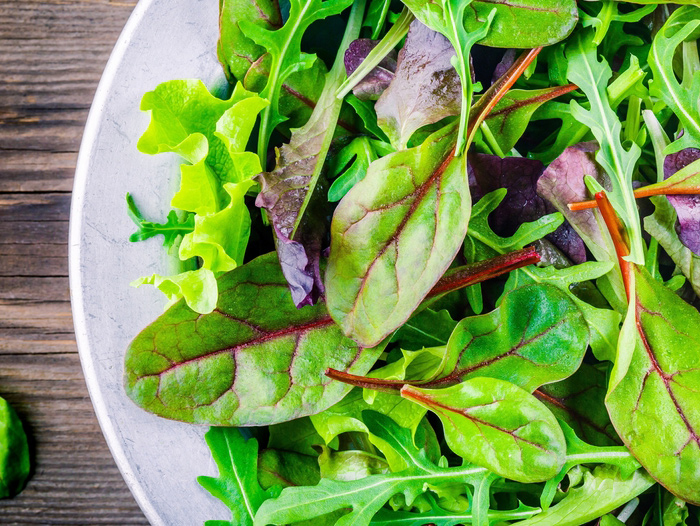Project Looks at Listeria Risk for Nontraditional Salad Ingredients
February 18, 2019 | 7 min to read

As nontraditional ingredients — such as beet greens, kale, Brussels sprouts and shredded broccoli stalks — gain popularity in fresh-cut salad mixes, questions have arisen about the potential risk of Listeria monocytogenes growth on them.
Amanda Lathrop, Ph.D., an associate professor at California Polytechnic, San Luis Obispo, Food Science and Nutrition Department, hopes the two-year interdisciplinary research project she’s leading will provide answers and help processors make better informed risk assessments.
“What people in the industry will tell you is these ingredients are becoming very popular,” Lathrop said. “But they’re not products that we’ve traditionally consumed raw and particularly in salad form.”
Although several past research projects have looked at Listeria monocytogenes and its relationship to spinach and Romaine lettuce, data is lacking for the four nontraditional salad ingredients, she said, citing a literature search.
“For beet greens, there was no information,” Lathrop said. “There was some work done with broccoli florets, but that’s a different part of the plant than the broccoli stalks. Shredded stalks have more surface area, cells are damaged more and there’s more moisture. There had been a little work done with kale, but sometimes with higher inoculum levels and the research didn’t look at as extensive a temperature range.”
Titled “The effects of storage conditions and the natural microbiome of nontraditional fresh-cut salad ingredients on the fate of Listeria monocytogenes,” the project will look not only at the fate of
Listeria but also how natural microbiomes and storage conditions may interact with the foodborne pathogen. Co-principal investigators are Jay Singh, Ph.D., and Koushik Saha, Ph.D., both of whom bring packaging expertise; and Christopher Kitts, Ph.D., who specializes in microbial ecology.
The research project involves three phases. The first is a challenge study, where each ingredient is inoculated with a known quality of L. monocytogenes in the lab and then incubated at 4, 12, 22, and 35 degrees Celsius (roughly 39 degrees Fahrenheit). The researchers also will conduct the same trials with the non-virulent L. innocua to verify it is a viable surrogate for future studies. At five different times, samples will be removed and the organism die-off measured. “We’re looking to see if we have growth, no growth or die-off,” Lathrop said. “The ideal would be die-off.”
At the same time, Kitts will lead testing on the microbiomes — communities of naturally occurring microbes present on the produce. This testing will provide further insight into how these microorganisms may influence L. monocytogenes growth, die-off or survival. Specifically, he will look for species that inhabit produce and have antibacterial activity. “Ultimately, we’d like to be able to develop some sort of biological control agent that prevents Listeria from growing,” Lathrop said. Their work also may be of interest to other researchers who are looking at whether the microbiomes found on produce benefit human health.
The third phase of their research will be to simulate optimal and abusive storage and distribution conditions the nontraditional salad ingredients may encounter from processor to retailer. To ensure their packaging reflects what is used commercially, Lathrop said they sought advice from two large fresh-cut processors about plastic bag composition and air exchange. Depending on the salad ingredients, bags have different porosity that matches air exchange with the ingredients’ respiration to prolong freshness. Ideally, packaged salads should be kept at 4 degrees Celsius (39 degrees Fahrenheit). To mimic an abusive situation, the researchers will inoculate the bagged ingredients withL. innocua and store them at three different less-than-ideal temperatures: 12, 22, and 35 degrees Celsius (54, 72, and 95 degrees Fahrenheit, respectively). Periodically, they will pull samples and measure the number of Listeria present.
Singh and Saha in Cal Poly’s Industrial Technology and Packaging Department will put bags of inoculated salad mix through vibration, shock and compression testing designed to simulate the abuse encountered during distribution. Then the bags will be incubated at 4 and 8 degrees Celsius (39 and 46 degrees Fahrenheit, respectively), sampled periodically, and the Listeria counted and compared to packages that weren’t abused. “That physical abuse may potentially increase or cause Listeria to grow more readily,” Lathrop said.
This project abstract may be found on the Center for Produce Safety website: The effects of storage conditions and the natural microbiome of nontraditional fresh-cut salad ingredients on the fate of Listeria monocytogenes
CPS Minute Video with Dr. Lathrop can be found on the CPS Videos page
Learn more about this project and other CPS funded research by visiting our Funded Research Projects page on the CPS website and by attending the 2019 CPS Research Symposium in Austin, Texas — June 18-19.
